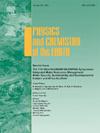Effect of textural and physical properties of the carbonate rocks on dynamic elastic modulus: application of statistical and intelligent methods
IF 4.1
3区 地球科学
Q2 GEOSCIENCES, MULTIDISCIPLINARY
引用次数: 0
Abstract
This study investigated the effect of physical and textural characteristics of limestone and dolomite samples on dynamic elastic modulus (Ed). First, water absorption, density, carbonate percentage, and hardness were measured, and textural properties using thin sections were determined. Then, the effect of textural and physical characteristics on dynamic characteristics was determined by statistical and machine learning (ML) methods. The results showed that the total textures in these rocks are mudstone, wackestone, and packstone. Wackestone and mudstone showed a negative impact on dynamic characteristics, while packstone has a positive impact on Ed. Regression analysis showed that the impact of physical properties on dynamic properties is less than textural properties. Meanwhile, among textural properties, mudstone showed the least effect on Ed. Support vector regression, Levenberg-Marquardt artificial neural network, and Gaussian process regression were used to validate the statistical methods. The correlation coefficient, root mean square error (RMSE), spider diagram, Nash Sutcliffe efficiency (NSE), A10, and A20 indices were used to evaluate the models. Intelligent methods are more accurate than statistical methods in estimating Ed. The LMANN with a correlation coefficient of 99 % and an RMSE of 0.07 %, A10 = 1.00, A20 = 1.00, and NSE = 0.99 showed the highest accuracy among the used models.
碳酸盐岩结构和物理性质对动态弹性模量的影响:统计和智能方法的应用
研究了石灰岩和白云岩样品的物理和结构特征对动态弹性模量(Ed)的影响。首先,测量吸水率、密度、碳酸盐百分比和硬度,并使用薄片确定纹理性能。然后,通过统计和机器学习(ML)方法确定纹理和物理特性对动态特性的影响。结果表明,这些岩石的结构主要为泥岩、微晶岩和包层岩。砾岩和泥岩对动态特性的影响为负向,而包覆岩对动态特性的影响为正向。回归分析表明,物性对动态特性的影响小于纹理性。同时,在纹理属性中,泥岩对Ed的影响最小。采用支持向量回归、Levenberg-Marquardt人工神经网络和高斯过程回归对统计方法进行验证。采用相关系数、均方根误差(RMSE)、蜘蛛图、Nash Sutcliffe效率(NSE)、A10和A20指标对模型进行评价。智能方法对Ed的估计精度高于统计方法,其中LMANN的相关系数为99%,RMSE为0.07%,A10 = 1.00, A20 = 1.00, NSE = 0.99,准确率最高。
本文章由计算机程序翻译,如有差异,请以英文原文为准。
求助全文
约1分钟内获得全文
求助全文
来源期刊

Physics and Chemistry of the Earth
地学-地球科学综合
CiteScore
5.40
自引率
2.70%
发文量
176
审稿时长
31.6 weeks
期刊介绍:
Physics and Chemistry of the Earth is an international interdisciplinary journal for the rapid publication of collections of refereed communications in separate thematic issues, either stemming from scientific meetings, or, especially compiled for the occasion. There is no restriction on the length of articles published in the journal. Physics and Chemistry of the Earth incorporates the separate Parts A, B and C which existed until the end of 2001.
Please note: the Editors are unable to consider submissions that are not invited or linked to a thematic issue. Please do not submit unsolicited papers.
The journal covers the following subject areas:
-Solid Earth and Geodesy:
(geology, geochemistry, tectonophysics, seismology, volcanology, palaeomagnetism and rock magnetism, electromagnetism and potential fields, marine and environmental geosciences as well as geodesy).
-Hydrology, Oceans and Atmosphere:
(hydrology and water resources research, engineering and management, oceanography and oceanic chemistry, shelf, sea, lake and river sciences, meteorology and atmospheric sciences incl. chemistry as well as climatology and glaciology).
-Solar-Terrestrial and Planetary Science:
(solar, heliospheric and solar-planetary sciences, geology, geophysics and atmospheric sciences of planets, satellites and small bodies as well as cosmochemistry and exobiology).
 求助内容:
求助内容: 应助结果提醒方式:
应助结果提醒方式:


